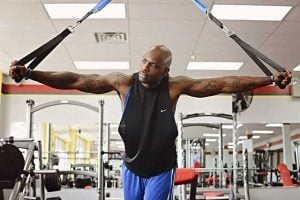Ideally, it’s said one should exercise at least every day. However, this remains to be a big challenge for most of us due to other activities like work or studying that leave us drained at the end of the day.
Morning hours would therefore seem like a good time to exercise, however that is also complicated by the early commute to work. Some would suggest waking up early but citing the importance of sleep it may be rather counter-intuitive to get inadequate sleep in favour of exercising.
So maybe the solution for all this could lie in the type of exercise one settles for. This is because traditional forms of exercise like playing a sport or going to the gym often require huge time investments, which only a few can accommodate in our busy schedules.
However, all this assumes that time is the issue and not the motivation to actually exercise in the first place. If this sounds like you, then you may want to give a try the scientifically proven 7-minute workout.
What is the 7-Minute Workout?

Just as the name suggests, this exercise consists of short routines that last approximately 7 minutes.
This exercise strategy, called the High-intensity Circuit Training (HICT), was published in the American College of Sports Medicine (ACSM) Journal back in 2013 and has since then grown quite popular.
It was designed to address the limitations of recommended exercise guidelines which however effective are not realizable for most people. To quote the study:
“Standard guidelines for aerobic training recommend 150 minutes per week of moderate-intensity exercise for 30 to 60 minutes per session and/or 75 minutes per week of vigorous-intensity exercise. Although these traditional protocols can be effective, they may not be realistic enough for time-conscious adults because of the amount of time necessary to complete each program….”
High-Intensity Circuit Training Using Body Weight: Maximum Results with Minimal Investment1
What is the science behind the 7-Minute Workout?
The exercise combines two principles, aerobic and resistance training, in 7 minutes routines which can be repeated two to three times depending on the time one has.
Aerobic exercise (also called “cardio”) is the type that increases your need for oxygen, resulting in increased heart and breathing rates. Some common forms of aerobic exercise include walking, jogging, running, cycling and swimming.2
Resistance training on the other hand is the type of exercise that causes muscles to contract against an external resistance. Common examples include weight-lifting and press-ups. This helps to build strength, anaerobic endurance, and size of muscles.3
In the 7-minute workout, you use your body weight as the resistance, and therefore you don’t need any exercising equipment.
The combination of these two principles at high intensity and with little rest is what gives the 7-minute workout potential to deliver many health benefits at much less time compared to traditional forms of exercise.1
What does the 7 minute workout involve?
The workout has a total of 12 short exercises arranged in a specific order. Each of these short exercise lasts 30 seconds with a 10 second rest time in between.
If you do the math (12 x 30 + 6 x 10 = 420 sec) that gives you a total of 7 minutes. The short exercises and where they target are as follows (in order):
- Jumping Jacks – Total body
- Wall Sit – Lower body
- Push-ups – Upper body
- Abdominal crunches – Torso
- Step-up onto chair – Total body
- Squats – Lower body
- Triceps Dip on chair – Upper body
- Plank – Torso
- High Knees (running in-place) – Total body
- Lunges – Lower body
- Push-up Rotations – Upper body
- Side Plank – Torso
Potential Health Benefits & Exceptions
The study behind the exercise reports that HICT can be a fast and efficient way for achieving weight and fat loss.
It can also help improve how your insulin works (insulin sensitivity), improve muscle fitness and maximal oxygen uptake (the amount of oxygen your body is capable of utilizing in one minute).1
This form of exercise or parts of it are however not recommended to people with certain health conditions. The study indicates that the wall sit, plank and side plank exercises are not recommended for people with hypertension or heart disease.
It further cautions that care should be taken when recommending the workout to people that are overweight or obese, detrained, those previously injured, the elderly and those with two or more diseases occurring at the same time (comorbidities).1
How to Get Started with the 7-Minute Workout
- You can start by watching some YouTube videos with real humans to understand how the exercises are done.
- Once you’ve an idea of how to do the invidual exercises, you can install a mobile app for your smartphone to help you schedule and time workout. Some apps include instructional videos as well as daily reminders to alert you when it’s time to exercise. The apps are available on all major platforms, including Android and Windows Phone. There are also apps for the iPhone, just search for them in the app store.
- It’s recommend you do two or three rounds of the exercise, but results can be seen with as little as one round. This may be hard for some at first, so do what you can and slowly increase the number of rounds the more you get used to it.
Suffice to say, if you do this the right way you’ll be sweating in no time. Also this shouldn’t be a total substitute for other forms of exercise. Whenever you can spare some substantial time do those other kinds of exercises that take much time.
REFERENCES
1. High-Intensity Circuit Training Using Body Weight: Maximum Results with Minimal Investment (Available here: http://journals.lww.com/acsm-healthfitness/fulltext/2013/05000/high_intensity_circuit_training_using_body_weight_.5.aspx)
2. Aerobic Exercise (https://en.wikipedia.org/wiki/Aerobic_exercise)
3. Strength Training (https://en.wikipedia.org/wiki/Strength_training)
4. NY Times – The Scientific 7-Minute Workout





